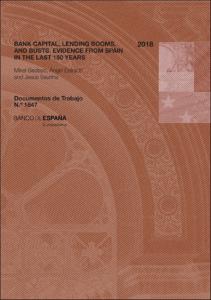Bank capital, lending booms, and busts : evidence from Spain in the last 150 years
Autor
Fecha de publicación
26-dic-2018
Descripción física
51 p.
Resumen
En este estudio analizamos el efecto del capital bancario en las expansiones y contracciones crediticias durante alrededor de 150 años en España. Primero construimos cuidadosamente una medida de apalancamiento bancario (i. e., ratio de capital sobre activo) para el sector bancario español desde el año 1880. Después, llevamos a cabo un análisis econométrico sólido para analizar el impacto de los niveles de capital bancario sobre los ciclos crediticios, controlando por otros factores de crecimiento de crédito. Encontramos evidencia empírica robusta sobre la relación asimétrica entre el capital bancario y el ciclo crediticio. En particular, un aumento del capital bancario antes de una expansión reduce el crecimiento del crédito, mientras que lo aumenta cuando llega una recesión. Por el contrario, un nivel de capital demasiado menguado ante una recesión tiene un impacto severo sobre la actividad crediticia (i. e., se puede incurrir en una escasez de crédito) con efectos negativos y duraderos en la economía y el bienestar de la sociedad en su conjunto. El artículo es particularmente útil para apoyar políticas macroprudenciales (provisiones dinámicas y colchones de capital anticíclico) que han sido implementados recientemente para alisar el ciclo crediticio. La experiencia de España durante más de un siglo con ciclos crediticios muy marcados permite analizarlos y respaldarlos, no solo basándonos en el último ciclo crediticio, sino también en los ocurridos en un pasado más lejano
In this paper we analyze the effect of bank capital on lending expansion and contraction for nearly 150 years in Spain. We first build up thoroughly a measure of bank leverage (i.e. the capital to assets ratio) for the Spanish banking sector starting in year 1880. Then, we run a proper econometric test to analyze the impact that bank capital levels have on lending cycles, controlling for other determinants of credit growth. We do find robust empirical evidence of an asymmetric relationship between bank capital and credit cycle. In particular, an increase in the bank capital before expansions reduces credit growth while it increases credit growth when the recession arrives. Conversely, a too depleted level of bank capital when entering in a recession has a severe impact on lending (i.e. may bring about a deep credit crunch) with quite negative and lasting effects in the economy and the wellbeing of the society as a whole. The paper is particularly useful to support macroprudential policies (dynamic provisions and the countercyclical capital buffer) that have been very recently put in place as they will help to smooth the credit cycle. The experience of Spain over more than a century, with very marked lending cycles, provides a fertile ground for analyzing and supporting them, not only based on the last lending cycle, but also on those occurred in the more distant past
In this paper we analyze the effect of bank capital on lending expansion and contraction for nearly 150 years in Spain. We first build up thoroughly a measure of bank leverage (i.e. the capital to assets ratio) for the Spanish banking sector starting in year 1880. Then, we run a proper econometric test to analyze the impact that bank capital levels have on lending cycles, controlling for other determinants of credit growth. We do find robust empirical evidence of an asymmetric relationship between bank capital and credit cycle. In particular, an increase in the bank capital before expansions reduces credit growth while it increases credit growth when the recession arrives. Conversely, a too depleted level of bank capital when entering in a recession has a severe impact on lending (i.e. may bring about a deep credit crunch) with quite negative and lasting effects in the economy and the wellbeing of the society as a whole. The paper is particularly useful to support macroprudential policies (dynamic provisions and the countercyclical capital buffer) that have been very recently put in place as they will help to smooth the credit cycle. The experience of Spain over more than a century, with very marked lending cycles, provides a fertile ground for analyzing and supporting them, not only based on the last lending cycle, but also on those occurred in the more distant past
Publicado en
Documentos de Trabajo / Banco de España, 1847
Materias
Ciclos crediticios; Crisis bancaria; Ratio de capital; Ratio de apalancamiento; Herramientas macroprudenciales; Lending cycles; Bank crisis; Capital ratio; Leverage ratio; Macroprudential tools; Fluctuaciones y ciclos económicos; Sistemas bancarios y actividad crediticia; Instituciones crediticias de depósito; España
Aparece en las colecciones:












